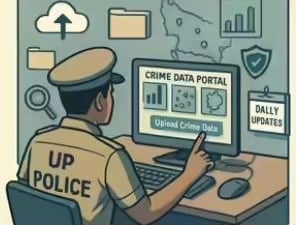One Year of BNS in Noida: Over 7,300 FIRs Registered, but Digital Evidence Collected in Just 13% Cases
It has been a full year since the rollout of the Bharatiya Nyaya Sanhita (BNS), India’s new criminal law framework aimed at modernizing the justice system with a strong focus on technology-driven investigations. Noida, a city often in the spotlight for its rapid urban growth and rising crime, has seen an impressive 7,300 First Information Reports (FIRs) registered under the new system.


By: Bharat Daily Samachar Date: 23 Sep,2025
Noida’s BNS Rollout: High FIR Numbers, Low Digital Evidence Usage Sparks Debate
It has been a full year since the rollout of the Bharatiya Nyaya Sanhita (BNS), India’s new criminal law framework aimed at modernizing the justice system with a strong focus on technology-driven investigations. Noida, a city often in the spotlight for its rapid urban growth and rising crime, has seen an impressive 7,300 First Information Reports (FIRs) registered under the new system. However, despite such large numbers, only 13% of these cases included digital evidence like CCTV footage, mobile records, or online data—raising questions about the effectiveness of law enforcement in the digital age.
This gap between on-paper reforms and ground-level implementation highlights both the opportunities and challenges of India’s criminal justice reforms. While the FIR numbers reflect active policing, the low use of digital tools shows that the vision of making investigations smarter and faster still has a long way to go.
Why Digital Evidence Matters
In today’s world, digital evidence is no longer an add-on—it is often the backbone of any strong case. CCTV footage, WhatsApp chats, call records, GPS data, and even social media posts can help reconstruct events with accuracy. Courts too increasingly rely on this form of evidence since it reduces ambiguity and strengthens convictions.
But in Noida, the numbers tell a different story. Out of 7,300 FIRs, only about 950 cases included digital proof, while the rest depended mostly on witness statements, physical evidence, or confessions. This creates a gap because traditional methods are often slower, less reliable, and open to manipulation.
Why is Digital Evidence Usage So Low?
Experts and senior police officials point to several reasons behind this low percentage:
Limited Resources: Many police stations in Noida still lack advanced forensic labs, trained cybercrime teams, or access to digital evidence tools.
Training Gap: Not all police officers are trained in handling, preserving, and presenting digital evidence in court.
Privacy Concerns: Extracting data from mobile phones or online accounts requires clear legal permissions, which can slow down investigations.
Public Cooperation: Sometimes, victims or witnesses hesitate to share their mobile data or private records, fearing misuse.
System Transition: Since BNS is still new, officers are adapting, and the full digital integration is expected to take more time.
Ground Reality: FIRs High, Convictions Still Slow
Registering FIRs is one thing, but securing justice in courts is another. Legal experts argue that without proper evidence, cases often drag on for years or result in acquittals. Digital proof not only speeds up trials but also makes convictions more likely.
For example, in a case of chain snatching last month, CCTV footage helped police nab the accused within 48 hours, making the investigation watertight. But such success stories remain rare compared to the total number of crimes registered.
What Authorities Are Saying
Police officials in Noida have admitted that improving digital evidence collection is now a priority. Plans are underway to:
Set up more cyber labs in Gautam Buddh Nagar.
Train frontline police staff in evidence collection and cyber investigation.
Encourage citizens and businesses to install CCTV cameras and share footage when required.
Build collaborations with telecom operators and tech companies for faster data access.
Senior officers also stressed that with time, the percentage of cases using digital proof will rise, as the system becomes more streamlined and officers gain experience with BNS procedures.
Citizen Concerns and Expectations
Many residents of Noida, especially those living in high-rise societies, say crimes like burglary, theft, and cyber fraud are rising. They feel safer when digital tools like CCTV cameras or neighborhood apps are part of investigations. However, they also worry about data misuse, privacy violations, and lack of accountability if proper safeguards aren’t in place.
Some activists have also called for public awareness drives so that citizens understand their rights and responsibilities when it comes to sharing digital data with police.
BNS: A Reform Still in Transition
The introduction of the Bharatiya Nyaya Sanhita was one of the biggest legal overhauls in India’s history, replacing colonial-era laws. It promised faster trials, digital-first processes, and citizen-friendly policing. But like any reform, its success depends on execution at the ground level.
In Noida’s case, the enthusiasm of registering FIRs shows progress, but the lag in evidence modernization highlights the distance left to cover.
The Road Ahead
For BNS to achieve its true potential in Noida and across India, digital evidence collection must become a core part of policing, not an exception. This means:
Investment in modern infrastructure like body cams, smart crime databases, and AI-powered tools.
Continuous training for police officers in handling tech-based crimes.
Building citizen trust so that more people are willing to share digital data.
Strong privacy laws and checks to prevent misuse of personal information.
If implemented effectively, these steps can ensure that justice is not just delayed less often, but also delivered more fairly and transparently.
Conclusion
The first year of BNS in Noida is a tale of two realities—on one hand, thousands of FIRs show active law enforcement, but on the other, the lack of digital integration shows a system still catching up with the times. For Noida, a city at the crossroads of tradition and technology, the future of policing will depend on how quickly it embraces digital tools.
If authorities manage to bridge this gap, Noida could set a national example in modern policing, proving that technology and justice can work hand in hand to make cities safer and fairer.
